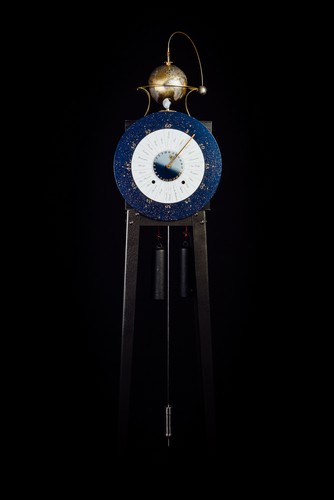


Clock "World":
Showing the time of all countries
|
 |
 |
|
Clock "World":
|
||
|
Mechanical clock showing the time in all the time zone, on a sole face, and all the movement of the earth and the moon Working of the hour : A long hand indicates the 60 minutes of the hour by a complete turn of the face. When this hand reaches the 60th minute, it activates the centrale circle which turns 1/24 th in the opposite direction of the traditional one (for a more pleasant movement, the disc makes a complete turn plus one hour to each time zone). The time-zone 180° at the bottom of the face, opposite the 0° greenwitch meridian, is marked with the line of date : it's a new day for the countries crossing this line. To set the clock to the correct time, you have to turn the hand of minutes in the traditional direction with your finger. The Earth and the Moon have to be ajusted separately. Working of the globe : It turns around its axel with a slope of 23,5° . The leaning axel permits to create the seasons. Working of the moon : 1) Sideral cycle of the moon : rising or going down. Definition : its the average value of time between two crossings of the moon in front of the same fix star in the sky ( except the sun ). This sideral cycle lasts 27 days, 7 hours, 43 minuts, 11,5 seconds ( = 27,32 days ) the moon turning around the earth indicates the sideral cycle, observed from the space . Four characteristic positions can be observed : 2 opposite positions where the moon is exactly in the same plan as the sun and the moon, called '' Eclipstic plan '' ( called '' Eclipstic plan '' because Eclips of sun and moon can only take place when the moon is in this position crossing the plan, either when rising, or when going down ) on the tops of it's rising, it's higher than the '' Ecliptic '' and lower when its at the lowest place of it's going down. 2) Synodic cycle increasing or decreasing moon. Definition : Its the average value of the time lasting between 2 successive unions of the moon and the Sun or between two new moons. The length of this cycle is 19 days 12 hours 44 minuts and 2,8 seconds. What makes a the oritically lunar day's length of 89 428''328744 for an earthy length of 86400'' ( the moon's phases increasing hour the new moon to the full moon and decreasing from the full moon to the new moon ) are only a game of shadows on the moon by the sun and have no influence on it's rotation . This cycle called ''synodic '' of the moon, shows its quarters : shadow flashed by the sun and the earth and variable, depending upon the positions of the sun, the earth and the moon. This chadow quarter seems to turn from the right to the left. The difference between these two days (3028''32 ) is therefore 50'28''32, delay taken by the moon compared with the sun. Difference between the working of this clock and the reality / The moon day furnished by this clock lasts 89428''256, that is tosay a difference with the reality of 0''72 a day ( 29,530 588 = - 2''12 a moon month ) It's a mathematical difference which doesn't take into account the imprecision of the clock working with a pendulum ( a few seconds a day ) that could be cheeked with a very precise mecanism, electric and radio conducted for instance. The creator of this clock has however prefered to stay in a mecanic working, in spit of this imprecision. C. Bernardet found it useful to install two moons on this clock, one for each cycle : in fact, we cant show with a sole example the sideral cycle seen from the space and the synodic cycle seen from the earth. This synodic cycle lasts 29 days,12 hours,44 minuts, 2,8 seconds ( = 29,53 days ) , the difference of time between a sidural cycle and a synodic one, that is to say 2,209 days, corresponds to the time necessary to find again the same alignement between the sun, the moon and the earth. This time, 2,209 days, multiplied by the number of sideral cycles in a year ( 13,368 cycles ) gives 29,53 days, that is to say a complete synodic cycle. As it was not possible to show the half in light anor the half in shadow of the moon with an electric lamp, the creator chose, as it's traditionnaly done, to paint a half white and a half black. This moon pivots on it's axel from light to left, in a synodic rotation of 29,53 days, whereas in the reality, the rotation on itself, of the moon, from left to right lasts 27,32 days ( a synodic revolution ) The difference between the two cycles is found again, that is to say 2,203 days : the time for the observer on the orbit of the earth during a sideral moon cycle. Notice that the time of the rotation of the moon on itself is exactly the same as the one of it's revolution around the earth : that's why only one face can always be seen from the earth. |
 |
||
| Home of Orrery.fr |